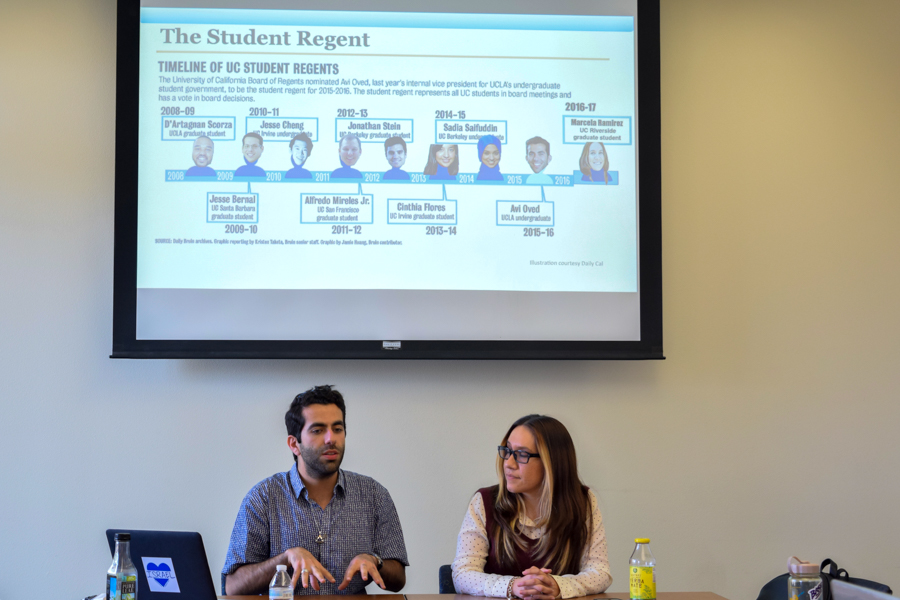
Regents Avi Oved and Marcela Ramirez discuss recruitment process for new student regent
On Feb 11, current University of California (UC) Student Regent Abraham “Avi” Oved and current UC Student-Regent Designate Marcela Ramirez held an informational session at UC Davis’ Student Community Center.
The visit is part of a 10-campus UC tour to discuss the recruitment process for becoming student regent. By the end of 2016, Oved will be terming out of his position as student regent and will be replaced by Ramirez for 2016-2017.
The meeting opened with a brief overview and history behind the position. In 1975, the UC student regent position was added in as a clause to UC policy during a time of heightened activism and an increased need for better representation.
Within that position, the student regent is granted a one-year voting position in all UC Board of Regents meetings. These meetings are held six times a year, with a two-day meeting happening every other month.
During the Student Regents term, he or she is also encouraged to pursue and represent other issues relevant to the UC system, including food security, homelessness and mental health training. In the past, student regents have been able to leverage campus-wide policies on tobacco use and pitched discussions on critical legislature.
Oved mentioned his own platforms as an example. Just recently, Oved’s Student Advisor Proposal was unanimously passed through the regents. With this proposal, Oved has added another non-voting student position to board meetings to help better represent students during the Regents meetings.
Ramirez and Oved also went over the application process behind the student regent position. The process starts with a three-part online application which asks for general information, a resume and a personal statement.
From there, the applications are narrowed down first by student groups and then by the Regents. In the beginning, the applications are reviewed and sorted out by each UC’s student government before moving on to the University of California Student Association (UCSA) for further review. Lastly, the remaining applications are sent to the Board of Regents for final decision.
According to Oved and Ramirez, each level of the process is in place to find certain aspects and strengths about an applicant. For instance, the UC student governments are judging a candidate’s local knowledge of the problems they wish to pursue during their term while UCSA is judging how effective the candidate can advocate for system-wide issues.
Sam Alavi, director of ASUCD’s Office of Advocacy and Student Representation (OASR), commented on the nature of the process and what UCSA is finding.
“The biggest thing UCSA looks for is whether the applicant has the best idea about what UC students, both undergraduate and graduate, have and need,” Alavi said.
During the meeting, Ramirez stressed a similar message to Alavi concerning the broad spectrum of representation that a student regent must hold.
“You are not just the student regent, like it’s a central part of who we are and why we’re at the table, but you also got to build alliances with staff and you also got to build alliances with faculty,” Ramirez said.
The concern for student voices is becoming increasingly more visible in light of recent decisions that were passed by the board. During the meeting, several students were able to voice their concerns over these decisions, such as increased admittance of California residents. There were several questions pitched over the lack of faculty and staff support alongside the rise in students. In response, Ramirez discussed the current and absent efforts of the university.
“There’s been a lot of faculty hiring across the system,” Ramirez said. “The staff conversation and the pressure, I think, that staff are under in terms of their workload with all these new people coming in […] there’s sort of advocacy and movement on that but the staff also needs our [Regent’s] help.”
All these comments further emphasize the weight and challenge behind the position of the student regent.
“It’s a balancing act, it’s a very, very thin line that you walk because you’re obviously there to champion student interests at the forefront,” Oved said. “But at the same time, when you cast your vote and you have conversations, they need to be reflective of the different stakeholders, they need to be reflective more comprehensive of UC as a whole.”
Written by: KATRINA MANRIQUE – campus@theaggie.org



